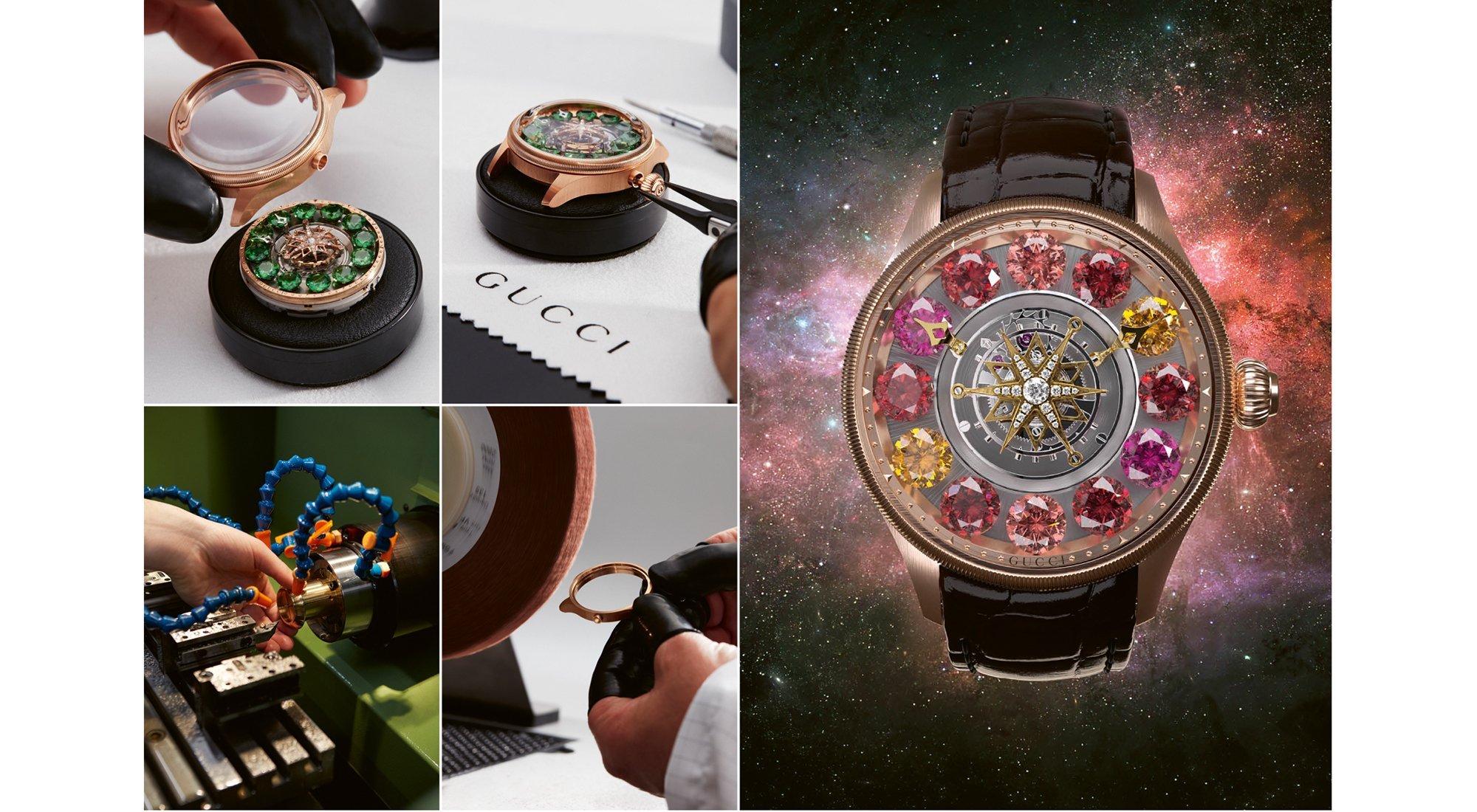hen you arrive at the building that houses the Gucci Watch Lab, Gucci’s production site in Cortaillod, nothing prepares you for what you are about to discover inside. An elegant, white industrial building from the outside, once you open the door you have the impression of being in the foyer of a Milanese boutique hotel. White walls, a black staircase, dark parquet flooring, furnishings in black and dark red overlooked by a gigantic photo of the G-Timeless Planetarium with its centrally placed tourbillon and 12 semi-precious stones revolving around the dial against a backcloth of the galaxy – the reception area sets the tone.
The Gucci Watch Lab is no ordinary watch production facility. Okay, movements are assembled and cased-up here, but with style. There is a genuine desire to instil beauty into the 9,000 square metres spread over three levels that the workshops cover. This is expressed most clearly on the uppermost floor, which consists of a showroom, a museum section, where the baroque showcases are custom-designed, and the reception area for customers who can sink into deep armchairs opposite a cheval mirror elegant enough to blend into the décor despite its imposing size.
In-house museum
Historically, Gucci’s watchmaking activities were spread over several sites, but only two have survived: one in Cortaillod, and one in Ticino, ideally situated close to the brand’s Milanese headquarters.
In the adjacent mini-museum, you find timepieces evidencing the already exuberant watchmaking creativity that existed when the company was still in the hands of the Gucci family: a handbag with a clasp embellished by a watch from the 1960s, a silver and blue enamel watch from the 1970s, a handful of models with a bracelet in Macassar wood or bamboo, following the example of the famous Bamboo bag first launched in 1947, as well as other vintage treasures.
To access the workshops, you pass through hallways topped by a glazed roof, which floods them with daylight. With its exposed tubes, the infrastructure is evocative of a scaled-down version of the brutalist architecture of the Pompidou Centre.

A revolution in progress
Some 140 employees work at the site. They are the ones who give that added stylish touch and strong identity to Gucci watches. “They” are the horology experts, prototypists, turners, the artisans who case-up the movements, the stone-setters.
One workshop is dedicated to finishing and the kind of know-how that calls for skilled artisans. This is where the traditional finishing operations are carried out: sand-blasting, bead-blasting, satin-finishing, sandblasted bevelling, etc. In a room given over to stone-setting, Gucci, a longstanding master of the art of setting diamonds in steel, gives its setters the opportunity to display their skills in Flamme setting, bezel setting on the crowns or snow-setting on the dials, and even invent new techniques depending on a timepiece’s specific needs. It is also in Cortaillod that the tiny bees which flutter on the hard-stone dial – in aventurine, tiger’s eye or opal – of the G-Timeless Dancing Bees are cut out in gold.
The radical turn taken by the company in 2021 has enabled it to move spectacularly up-market. And the watch that marked this evolution was the GUCCI 25H model, fitted with an automatic movement with a micro-rotor just 3.7mm thick. It was designed and developed exclusively for Gucci and assembled at the Gucci Watch Lab. The second momentous and revolutionary occasion at Gucci was the launch, in 2022, of the G-Timeless Planetarium featuring a central tourbillon with a diamond at its centre, surrounded by 12 semi-precious stones that dance around the dial.
A visit to the Gucci Watch Lab really brings home how far the brand has evolved in such a short space of time. And, given how assiduously certain production plans are hidden from visitors’ eyes, it’s a fair bet that the best is yet to come.









